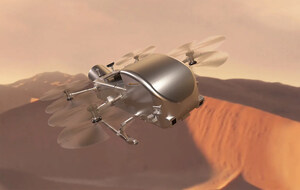HAMPTON, Va., Dec. 23, 2013 /PRNewswire-USNewswire/ -- In 2013, NASA's Langley Research Center in Hampton, Va., continued to advance science, aeronautics and exploration. From dropping a helicopter to building and testing future space vehicles, it's been a busy year. Check out our "Top 11" list of amazing accomplishments for 2013.
(Logo: http://photos.prnewswire.com/prnh/20081007/38461LOGO)
To see this article with high-resolution images online, go to the NASA Langley web site at http://www.nasa.gov/larc/2013-nasa-langley-year-in-review.
11. NEW TOWN RISING
More than 100 buildings at NASA Langley are 50 years or older. Through an architectural revitalization project known as New Town, the center continues to replace or update its aging infrastructure with energy efficient, state-of-the-art facilities.
Related Articles:
+ NASA Langley's 20-Year Revitalization Plan
+ NextGen Takes Flight With Air Traffic Operations Lab Upgrades
+ Demolitions Make Way for Future
10. SHAKE, RATTLE AND BOOM
If commercial airliners were so quiet you could barely hear them, living near airports might be desirable, and supersonic flight would not be restricted because of sonic booms. NASA engineers are working on ways to reduce jet engine noise, sonic booms, and noise in airplane cabins, too.
Related Article:
+ Listening for the Boom and Rattle of Supersonic Flight
9. RESEARCHERS WANT PLANES TO BUG OFF
Flightless fruit flies may some day help make airplanes more fuel-efficient. Langley researchers use them to test nonstick coatings in the lab before the materials are mounted on a plane. Engineers flight tested eight coatings on the wings of Langley's HU-25C jet during the buggy summer months. Rough airflow, created by bug remains and other factors, increases airplane fuel usage — as much as 30 percent.
Related Articles:
+ NASA Researchers to Flying Insects: 'Bug Off!'
+ Nothing Bugs These NASA Aeronautical Researchers
8. TESTING A 'DREAM'
A reusable spacecraft called Dream Chaser that could ferry astronaut crews to and from low-Earth orbit is undergoing tests at Langley, from landing simulations by astronauts to high-speed wind tunnel runs.
Related Articles:
+ Langley Tests Dream Chasers Thermal Dynamics
+ Astronaut Pilots a "Dream" at NASA Langley
7. FLYING ON A WING, PRAYER AND PLANT OIL
NASA completed flights that studied the effects of biofuel, made with camelina plant oil, on engine performance, emissions and aircraft-generated contrails at altitudes flown by commercial airliners. The experiment involved a NASA airplane flying as high as 39,000 feet while another trailed behind taking measurements. Researchers say the biofuel mixture burned cleaner than regular fuel with no reduction in performance.
Related Articles:
+ NASA Researchers Sniff Out Alternate Fuel Future
6. PREPARING FOR THE WORST
If a launch should go bad on NASA's next-generation spacecraft, a system designed at Langley will ensure that astronauts and the crew module are jettisoned out of harm's way. The Launch Abort System has undergone extensive testing, and the tower for the system was recently completed.
Related Articles:
+ First Testing of Orion Launch Abort System Flight Hardware
+ LAS Tower Complete in Preparation for Orion's First Mission
5. FLYING THROUGH THE SMOG
A challenge for satellites measuring air quality is to distinguish between pollution high in the atmosphere and that near the ground. A multi-year NASA campaign is tackling the challenge, and two deployments were conducted this year in Texas and California. The project is called DISCOVER-AQ, or Deriving Information on Surface conditions from Column and Vertically Resolved Observations Relevant to Air Quality.
Related Articles:
+ Major NASA Air Pollution Study to Fly Over Houston
4. OF WIND AND ROCKETS
Environmental conditions like wind gusts can affect a launch vehicle's performance, so it makes sense to do a lot of testing in advance to make sure it works right. NASA's new Space Launch System has undergone a series of wind tunnel tests to prepare for its first mission in 2017.
Related Articles:
+ Wind Tunnel Testing Used to Ensure SLS Will 'Breeze' Through Liftoff
3. TEST A SMASHING SUCCESS
Anybody who says NASA researchers don't know how to have a smashing good time has not met a team at Langley. They are test engineers whose job it is to make aircraft safer by crashing them. In late August, they dropped a 45-foot-long helicopter fuselage to test seat belts and seats. NASA collaborated with the Navy, Army and Federal Aviation Administration in a full-scale crash that featured 15 crash test dummies.
Related Articles:
+ Teamwork Makes Chopper Drop a Success
2. 'PLAN B' FOR AN ASTEROID
There's more than one way to find, capture and relocate an asteroid from deep space into the Earth-Moon system and Langley engineers were charged with developing an alternative.
Related Articles:
+ NASA Develops Additional Concept for Asteroid Redirect Mission
1. ENSURING A SAFE RETURN
When NASA's next generation spacecraft carries people into the cosmos, their safe return to Earth will be a critical element of the mission. Last summer, NASA and the Navy joined forces to practice recovering the Orion crew module that would splash down in the Pacific after completing a flight.
Related Articles:
+ Test at Naval Station Proves Recovery Operations for Orion
For more information about Langley go to http://www.nasa.gov/langley
NASA Langley news releases are available automatically by sending an e-mail message to [email protected] with the word "subscribe" in the subject line. You will receive an e-mail asking you to visit a link to confirm the action. To unsubscribe, send an e-mail message to [email protected] with the word "unsubscribe" in the subject line.
SOURCE NASA
WANT YOUR COMPANY'S NEWS FEATURED ON PRNEWSWIRE.COM?
Newsrooms &
Influencers
Digital Media
Outlets
Journalists
Opted In




Share this article